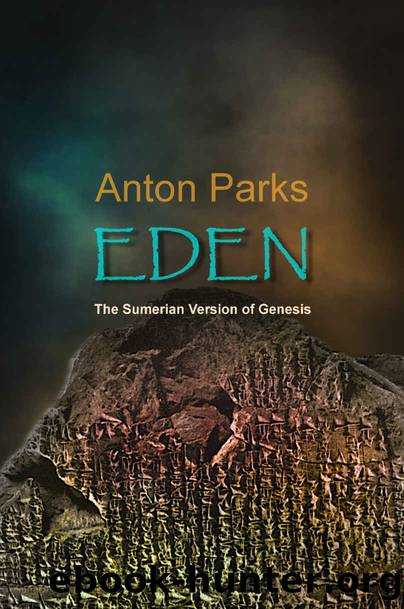EDEN - The Sumerian Version of Genesis by Anton Parks

Author:Anton Parks [Parks, Anton]
Language: eng
Format: epub, mobi
Published: 2020-05-19T22:00:00+00:00
CBS 8322, face b, col. 4, lines 1-10
This fourth and last column tells us that the Serpent revealed the forbidden Secret of metallurgy. It seems that he didnât do this inside the settlement, but on its edge. At first glance, this does not seem to fit with what was written in lines 5 and 6 of column 2, in which we can read: "Each time that Enki was present, he let [man] taste [his] fate, alas, in the property..." It may be that the term "property" included all the plantations in KharsaÄ and Kalam (Sumer) that belonged to the gods. It was there, under the great trees, sheltered from prying eyes, that Enki is supposed to have betrayed the Secret. Considering the catastrophic results of this betrayal, it may be supposed that EnlÃl or one of the other gods observed him while he did this.
If you ask me, Enki did not begin the work of civilizing the humans in the regions of the Taurus and Kalam (Sumer), practically in front of his companions from the heavens. Would he have taken the risk of getting caught just as he was getting started? It would be more logical that Enki revealed this Secret elsewhere and would have continued in Kalam and at KharsaÄ in order to complete his civilizing work. As we have seen, Enki did his best to travel wherever he could, especially in Africa. He probably did this in order to be in contact with humans and to get some distance from his fellow-gods, with whom he does not seem to have had much affinity.
It so happens that the oldest-known piece of metal ever discovered was unearthed in Iraq in 1960, about 136 miles away from the presumed site of KharsaÄ, in Kurdistan. This was a copper pendant found in the cave of Å anidar. It was precisely because it was found in a cave, that is, protected from the weather, that it was able to survive at all, not to say in such good condition. It has been dated to around 9500 and 10000 years B.C.[202] According to general scholarly opinion, no culture was in a position to work copper at that time. Further excavations at the site of Å anidar have brought much information to light about the Neanderthal men who lived there and their remains, but next to nothing about this strange object that calls standard scientific opinion in question. This type of copper object appeared in the Near East usually only around 4000 or 3500 B.C., yet the necklace from the cave at Å anidar is a perfect piece of work and presupposes a mastery of metallurgical techniques.
Michael Cremo and Richard Thompson published a book in 1993 titled Forbidden Archeology[203] in which they established a list of unusual archaeological finds from the last few centuries. Among the many metal artifacts, there were some that were several tens of thousands of years old, if not older. The book caused a sensation, but was greeted with ridicule by the scientific establishment.
Download
EDEN - The Sumerian Version of Genesis by Anton Parks.mobi
This site does not store any files on its server. We only index and link to content provided by other sites. Please contact the content providers to delete copyright contents if any and email us, we'll remove relevant links or contents immediately.
Machine Learning at Scale with H2O by Gregory Keys | David Whiting(3640)
Never by Ken Follett(3534)
Fairy Tale by Stephen King(2953)
The Man Who Died Twice by Richard Osman(2811)
Reminders of Him: A Novel by Colleen Hoover(2770)
Will by Will Smith(2581)
It Starts With Us (It Ends with Us #2) by Colleen Hoover(2044)
The Dawn of Everything: A New History of Humanity by David Graeber & David Wengrow(2018)
Can't Hurt Me: Master Your Mind and Defy the Odds - Clean Edition by David Goggins(2004)
Friends, Lovers, and the Big Terrible Thing by Matthew Perry(1998)
The Stranger in the Lifeboat by Mitch Albom(1937)
The Becoming by Nora Roberts(1920)
Love on the Brain by Ali Hazelwood(1818)
New Morning Mercies: A Daily Gospel Devotional by Paul David Tripp(1814)
HBR's 10 Must Reads 2022 by Harvard Business Review(1698)
The Strength In Our Scars by Bianca Sparacino(1695)
A Short History of War by Jeremy Black(1672)
Go Tell the Bees That I Am Gone by Diana Gabaldon(1601)
515945210 by Unknown(1522)
